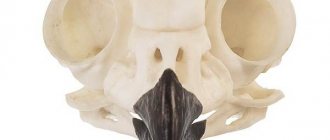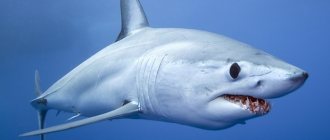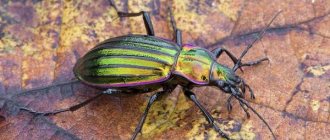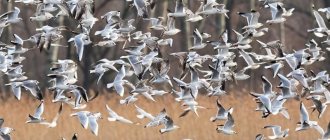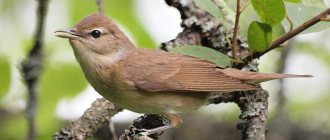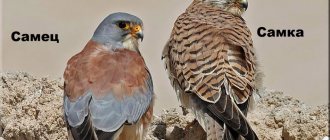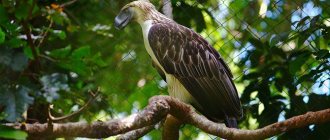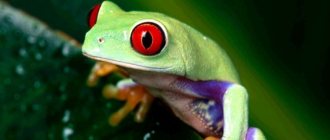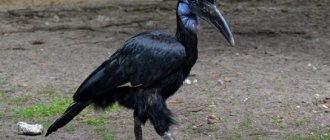Woodpeckers are widespread in Eurasia and North Africa. These birds are loud, noisy and noticeable due to their bright, motley plumage, made in black and white with a bright red cap at the back of the head.
| Latin name: | Loxia |
| English name: | Crossbill |
| Kingdom: | Animals |
| Type: | Chordata |
| Class: | Birds |
| Squad: | Woodpeckers |
| Subfamilies: | Woodpeckers, Woodpeckers, Nesoctitinae, True woodpeckers |
| Genus in the Herticaceae: | Verticheyki |
| Woodpecker genera: | Woodpeckers, Red Woodpeckers |
| Genus nesoctitinae | Antillean woodpeckers |
| Tribes are real woodpeckers | Hemicircini, Campephilini, Melanerpini, Picini |
| Body length: | |
| Wing length: | |
| Wingspan: | |
| Weight: |
Description of the bird
Woodpecker is a bird that knocks on wood.
— Advertising —
Woodpeckers are small to medium-sized birds that are primarily arboreal. Their long, straight, cone-shaped beak allows them to extract insects directly from under the bark of trees. The woodpecker's skull is large and strong. The tail is wedge-shaped, made of hard feathers, which allows it to be used as a support. The plumage of all species is motley, black and white, with red or yellow markings on the head and other parts of the body.
Character and lifestyle of the spotted woodpecker
The life of such birds mainly passes on tall trees, which they are excellent at climbing, even better than flying. The spotted woodpecker's adaptability to such living conditions is admirable.
Nature has provided it with a pointed tail, equipped with hard feathers, which serve these creatures when moving along tree trunks. The structure of the limbs is also curious. The arrangement of the fingers on them is such that the front pair is opposed to the back pair, which helps woodpeckers stay at a considerable height, deftly maintaining balance.
Birds use their wings only when the need arises to fly from tree to tree. A straight, powerful beak often turns out to be an excellent way for birds to communicate and transmit information.
Woodpecker flight
By drumming with all its might on pieces of iron and empty cans, the spotted woodpecker communicates with its relatives, notifying them of its location. The voice of these birds is hoarse and nasal; they are quite noisy and make sounds similar to “kick” or “ki-ki-ki”.
Listen to the voice of the Great Spotted Woodpecker
These birds live sedentary lives and prefer not to move long distances, but sometimes they are forced, especially in the northern regions, to move to neighboring areas in search of sufficient food.
Woodpeckers prefer a solitary life. Each individual has its own feeding area, and the distribution of its boundaries often gives rise to conflicts between neighbors, with only representatives of the same sex fighting.
But fights can be brutal, and aggressive actions are expressed in blows with sharp beaks, and even wings are used in such brawls. Taking a threatening pose and warning the opponent about the fight, woodpeckers ruffle the feathers on their heads and open their beaks.
These are brave winged creatures, and they do not experience much fear of predators. But they are careful, and possible danger can force them to hide. Woodpeckers prefer not to notice humans, almost always being indifferent to the presence of two-legged observers in the forest.
Unless they lazily move to the opposite side of the trunk, away from prying eyes. But too much interest can cause birds to fly to a quieter place.
For hundreds of years, humans have not particularly threatened this genus of birds. The bird population is quite large and is not in danger of being destroyed. However, some species are still listed in the Red Book
In particular, over the last decade there has been a significant decline in the number of the common spotted woodpecker. The cause of the problem was the cutting down of oak forests, their favorite habitats. Nature reserves are being created to protect this species of birds.
What do they eat?
Depending on the season and habitat, woodpeckers prefer animal or plant food.
In spring and summer, woodpeckers eat large quantities of various insects and larvae. Their food includes beetles (longhorned beetles, bark beetles, golden beetles, horn beetles, leaf beetles, ladybugs, weevils, ground beetles), caterpillars and adult butterflies, horntails, and aphids. Woodpeckers readily feed on ants; ornithologists found from 300 to 500 of these insects in the stomachs of individual individuals. Woodpeckers also eat crustaceans and mollusks.
— Advertising —
Woodpeckers obtain such food on tree trunks or on the ground. The woodpecker sits on the trunk from below and climbs up in a spiral, inspects the cracks along the way and launches its long tongue (about 4 cm) into them. When insects are detected, the woodpecker breaks the bark with its beak or makes a funnel from which it takes the prey to the surface. From a height of 12 to 16 m, the woodpecker flies to the next tree. The bird rarely pecks at healthy trees and chooses those that are withered or damaged by pests. On the ground, woodpeckers destroy anthills.
In winter, woodpeckers often move closer to human habitation, where they feed on bird feeders or look for food of anthropogenic origin in garbage dumps. Sometimes they can feed on carrion or destroy the nests of songbirds, eating eggs and chicks.
During this period, birds also switch to plant foods - seeds of coniferous trees, nuts and seeds of hazel, beech, oak, hornbeam, almonds, and acorns. Woodpeckers peck out the seeds and feed on the pulp of gooseberries, currants, cherries, plums, raspberries, junipers, buckthorns and ash. In spring, birds can break through the bark of trees and drink the sap.
Nutrition
In the oak forests of the Belgorod region, the woodpecker's summer diet consists of more than 63% adult black garden ant.
The diet consists almost entirely of animal feed. During the breeding season, it is not much different from that of the great spotted woodpecker, however, in search of food, the woodpecker is reluctant to chisel the bark and rarely eats the larvae of xylophagous insects hidden under it. As a rule, the bird moves quickly from one place to another, while examining tree trunks, branches and the surface of leaves in search of various woody invertebrates. Unlike larger species, it even moves along thin branches and, like tits, sometimes hangs at their ends. It prefers dead wood; about a third of the time it feeds in the wood of dead trees. Just like some other spotted woodpeckers, it sometimes practices the so-called “forge” - a crevice in the bark or a self-made hole into which it inserts nuts and seeds before chiseling them. However, in comparison with the Great Spotted Woodpecker, this function is much less developed in the average one, and the “forge” is usually not used more than 3-4 times.
It eats large quantities of butterfly caterpillars (including hairy ones, which are not touched by other birds), adult beetles (hooded beetles, soft beetles, ground beetles, longhorned beetles, leaf beetles, weevils, click beetles, melyrids, false elephants, rove beetles), pupae and imago hymenoptera (ants, bees, horntails, sawflies), dipterans (marsh bugs, mosquitoes, centipedes), bugs, aphids and other insects. In autumn and winter, the proportion of some groups of insects decreases, while others increase (for example, according to some data, a certain proportion of ants are replaced by bedbugs). In addition, in the cold season, a small part of the diet consists of plant foods - acorns, grains of barley and wheat, fruits (nuts) of large hazel, beech and walnut, and occasionally seeds of coniferous trees.
Where do they live?
In Africa, woodpeckers are common in Algeria and Tunisia, Morocco and the Canary Islands of Tenerife and Gran Canaria.
In Europe they live almost everywhere, except for Ireland, Scandinavia and the Russian Arctic. In the Balkans and Asia Minor they are found in the mountains. A large population lives in the Caucasus, Transcaucasia and northern Iran in areas near the Caspian Sea.
The habitats of woodpeckers are very diverse: from the northern taiga to forest plantations, gardens and parks. Birds nest up to the upper border of the forest: on average up to 2000 m above sea level. In all regions of their habitat, woodpeckers are sedentary birds, and migrate only in case of food shortage.
Habitat
The distribution area covers the temperate and southern latitudes of Europe, as well as a small part of Western Asia. The most western isolated settlements of this bird are noted in the north of Spain in the Cantabrian Mountains, as well as in the Pyrenees on the border of Spain and France. In some places it nests in mainland Italy and on the islands of the Mediterranean Sea - Sardinia, Corsica and Sicily. More or less densely settled to the east of the northern and central regions of France - in Central, Southern and Eastern Europe up to the Baltic states and western regions of Russia. In Northern Europe, including Scandinavia, the common spotted woodpecker is not found at all, although it previously nested in Denmark until 1959 and until 1982 on the Swedish island of Gotland.
In contrast, in eastern Europe, the woodpecker's range began to expand eastward, starting around the mid-1980s. At that time, the northeastern border of the range passed through Latvia, Belarus, Kaluga, Tula, Kursk, Lipetsk, Voronezh, Kharkov and Dnepropetrovsk regions. By the mid-2000s, numerous sporadic settlements of the bird were also noted in Estonia, in the Smolensk, Moscow, Ryazan, Penza, Saratov, Volgograd and Rostov regions.
In the southeast of its range, the woodpecker inhabits the slopes of the Greater Caucasus, Transcaucasia, Turkey (Pontic Mountains, Eastern Taurus, Aegean coast) and Iran (Zagros, Fars). In the Aegean Sea it breeds only on Lesbos.
Common woodpeckers usually live in places where there are diseased and dead trees.
Inhabits mature deciduous and coniferous-deciduous forests located on the plain, in river valleys and foothills. It rarely settles in old abandoned parks and apple and pear orchards on the border of deciduous forests - in particular, this is typical for Germany, Austria and Switzerland. In Germany it was also observed in pine forests generally unusual for this species. The anatomical features of the common spotted woodpecker are less adapted to chiselling, and for this reason its habitats tend to be associated with an abundance of diseased and dead trees. In most of Europe they are almost always associated with plantings of various species of oak, often with an admixture of hornbeam, elm, alder, spruce, beech or ash. The highest density of settlements, about 100 individuals per km2, is achieved in mature oak and hornbeam groves. Birds avoid the pure, oak-free, hornbeam and beech forests characteristic of Central Europe, as well as fairly young (up to 60 years old) and vice versa ancient oak forests. In the north and northeast of the range, the nature of the forest changes noticeably - the woodpecker often nests in alder-ash swampy lowlands, both with dense stands and sparse ones. In the southeast it inhabits floodplain forests with thickets of sedge and willow, often cluttered and with a lot of rotten wood. In Turkey, among other things, it settles in olive groves.
As a rule, it does not penetrate high into the mountains: in most of Central Europe it is found no higher than 600-700 m, in the Carpathians up to 800-1000 m, in Transcaucasia up to 900 above sea level. In the lower part of the mountains it is noted only in places in the southern part of the range: in Italy it nests up to 1700 m, in Anatolia up to 1300 m, in the southwest of Iran up to 2300 m above sea level.
Tribes True Woodpeckers
- Genus in tribe hemicircini - Short-tailed woodpeckers
- Genus in the tribe hampephilini - Blyth's woodpeckers, Orange-backed woodpeckers, Sultan's woodpeckers, Royal woodpeckers
- Genus in the tribe melanerpini - Sucker Woodpeckers (Sphyrapicus), Cuban Green Woodpeckers (Xiphidiopicus), Melanerpes Woodpeckers (Melanerpes), Three-toed Woodpeckers (Picoides), Yungipicus, Leiopicus, Savannah Woodpeckers (Dendropicos), Spotted Woodpeckers (Dendrocopos), Dryobates, Leuconotopicus, Veniliornis Woodpeckers
- Genus in tribe p icini - Chrysophlegma, Green Woodpeckers (Picus), Ground Woodpeckers (Geocolaptes), Campetera Woodpeckers (Campethera), Indo-Malayan Woodpeckers (Dinopium), Bamboo Woodpeckers (Gecinulus), Red-headed Woodpeckers (Micropternus), Pileated Woodpeckers ( Meiglyptes), Band-bellied Woodpeckers (Piculus), Avocetous Woodpeckers (Colaptes), American Woodpeckers (Hylatomus), Woodpeckers (Dryocopus), Mullerian Woodpeckers (Mulleripicus), Celeus Woodpeckers (Celeus)
Common types
Great spotted woodpecker (Dendrocopos canicapillus)
The photo shows a great sharp-winged woodpecker.
A small bird with a long, straight beak. Body length is from 14 to 16 cm. Body weight ranges from 20 to 30 g. The plumage is motley, black and white above and whitish-gray below. At the bottom of the back there is a light diamond-shaped spot. The forehead and crown are brownish-gray, the back of the head is black. The male has red feathers on the back of his head. Dark “whiskers” begin from the beak. The cheeks and throat are white. The back is dark. The belly is whitish-gray with dark streaks. The iris is red-brown or red, the legs and beak are dark gray. Juveniles are darker and motley. Females do not have red feathers on the back of their heads, but otherwise they do not differ from the male.
The species is distributed in eastern and southeastern Asia.
Brown-fronted Woodpecker (Leiopicus auriceps)
This is what a brown-fronted woodpecker looks like
. A medium-sized woodpecker that lives in the foothills and lower belt of the Himalayas (Afghanistan, Pakistan, India and Nepal).
The body length reaches 20 cm, weight from 37 to 50 g. The beak is of medium length, chisel-like, with a wide base. The plumage on the back and wings is motley, black and white, the belly is light, the “cap” is colorful. The forehead is yellowish-brown in both males and females. But the male has a lemon-yellow crown and the back of the head is red, while the female has both the crown and the back of the head yellow. The cheeks and chin are white with a black mustache. The chest and belly are white with dark streaks.
Yellow-breasted Woodpecker (Dendrocopos macei)
Photo of a yellow-breasted woodpecker on a tree.
The species' habitat includes countries such as Bhutan, Bangladesh, Cambodia, India, Indonesia, Laos, Myanmar, Nepal, Pakistan, Thailand and Vietnam.
Medium sized woodpecker. The plumage on the back is black with white transverse stripes. The breast is light brown. Neck with black stripes on each side. Males have a red head with an orange forehead, females have a black head.
Spotted Woodpecker (Dendrocopos atratus)
Photo of a spotted woodpecker
A small bird with a dense build, a resident of Indochina. Body length up to 22 cm, weight from 42 to 52 g. The back and wings are black with a white spotted pattern. The neck is whitish, the breast and belly are yellowish-ochre in color with thin longitudinal black streaks. The undertail is red. The sides of the head are white with a black stripe of “whiskers”. The male has a bright red cap of feathers running from his forehead to the back of his head. The female's is black.
Yellow-capped woodpecker (Dendrocopos mahrattensis)
The species is widespread in Hindustan and Indochina. This is a small bird with a long straight beak. Body length is about 18 cm, weight from 28 to 46 g. The plumage in the forehead and crown is golden yellow. The nape of the male is bright red, while that of the female is brownish-ochre. The “whiskers” are weakly expressed. The cheeks, chin and throat are white with brown spots. The body at the top is black or black-brown with white spots and streaks, the lower back is white. The belly is white with an orange-red spot in the center. Young birds are feathered brown.
Red-bellied or red-necked or red-breasted woodpecker (lat. Dendrocopos hyperythrus)
Body length from 20 to 25 cm, weight from 53 to 74 g. The beak is long. The male's back is black with white transverse stripes, his belly is reddish-chestnut. The female has a brown back. Males have a shiny red cap on their heads, while females have a black cap with white spots. The legs are gray, the iris is red.
The habitat begins in the Himalayas from Kashmir to Assam. The bird is also found in China, Vietnam and Thailand.
Middle Spotted Woodpecker
- Latin name: Leiopicus medius, Dendrocopos medius
- Body length: 22 cm.
- Weight: from 50 to 85 g.
- Order: Woodpeckers
- Family: Woodpeckers
- Genus: Spotted Woodpeckers
- Conservation status : Least Concern
The head is rounded, the beak is short, dark gray. The upperparts are black with white streaks on the wings. The belly and sides are yellowish with dark longitudinal streaks. The iris is red-brown, the paws are gray. The “whiskers” are weakly expressed. There is a bright red cap on the crown. Young birds are dull.
The species nests in temperate and southern latitudes of Europe, as well as in Western Asia. Habitat: broad-leaved, mixed forests, most often dominated by oak.
Photo: Middle Spotted Woodpecker
The Middle Spotted Woodpecker is similar to the Great Spotted Woodpecker, but if you look closely the two birds are noticeably different from each other. The color of the average spotted woodpecker is not as bright as that of the great one. It knocks less, in the summer it spends most of its time in the crown of trees and practically does not fall to the ground.
White-backed Woodpecker (Dendrocopos leucotos)
Body length is from 26 to 31 cm, wingspan is 44-49 cm, body weight is from 100 to 130 g. The male has a white forehead and sides of the head, a red “cap” with white spots, the back of the head and back are black. The mustache is black. The belly is white, with an ocher coating; sides with dark longitudinal streaks. The undertail is pink. The female has a black cap on her head.
The bird lives in the south of Eurasia.
Great Spotted Woodpecker
- Latin name: Dendrocopos major
- Body length: 22-27 cm.
- Wingspan: 42-47 cm.
- Weight: 60-100 g.
- Order: Woodpeckers
- Family: Woodpeckers
- Genus: Spotted Woodpeckers
- Conservation status : Least Concern
Body length is from 22 to 27 cm, wingspan is 42-47 cm, weight is from 60 to 100 g. The plumage is dominated by black and white tones, the undertail is bright red. The top of the head, back and rump are black. The forehead, cheeks, shoulders and tummy are brownish-white. The tail is black. The iris is brown or red, the beak is black, the legs are dark brown.
The species is found in Africa, Europe and Asia Minor.
Syrian woodpecker (Dendrocopos syriacus)
The bird's habitat covers Asia, Central and Eastern Europe.
Body length up to 23 cm, weight from 55 to 80 g. The top of the head is black, the forehead, sides of the head and cheeks are white. The male has a bright red stripe on the back of his head; the female does not have it. The "whiskers" are well developed. The throat, neck and belly are off-white. The undertail is red. The iris is red. The beak is dark gray. Paws are gray.
White-winged Woodpecker (Dendrocopos leucopterus)
The species is found in Central Asia, Dzungaria and Kashgaria.
Body length from 22 to 24 cm, weight about 70 g. Beak of medium length, straight. There are large white spots on the shoulder blades and wings, the belly and undertail are bright red. The forehead is white.
Recommendations
- BirdLife International (2016). " Leiopicus medius
".
IUCN Red List of Threatened Species
.
IUCN. 2016
: e.T22681114A87306174. Doi:10.2305/IUCN.UK.2016-3.RLTS.T22681114A87306174.en. - Linnaeus, Karl (1758). Systema Naturae per regna tria naturae, minor classes, ordinal, genera, species, cum characteribus, differentials, synonyms, loci
(in Latin). Volume 1 (10th ed.). Holmiae (Stockholm): Laurentii Salvii. paragraph 114. - Jobling, James A. (2010). Helm Dictionary of Scientific Names for Birds
. London: Christopher Helm. paragraph 245. ISBN 978-1-4081-2501-4. - Peters, James Lee, ed. (1948). Checklist of Birds of the World
. Volume 6. Cambridge, MA: Harvard University Press. paragraph 188. - Fuchs, J.; Pons, J. M. (2015). "A new classification of the spotted woodpecker community (Dendropicini, Picidae) based on a comprehensive multilocus phylogeny." Molecular phylogenetics and evolution
.
88
: 28–37. Doi:10.1016/j.ympev.2015.03.016. - ^ a b
Gill, Frank;
Donsker, David; Rasmussen, Pamela, ed. (2020). "Woodpeckers". IOC World Bird List, version 10.1
. International Union of Ornithologists. Retrieved May 27, 2022. - Cabanis, Jean; Heine, Ferdinand (1863). Museum Heineanum: Verzeichniss der ornithologischen Sammlung des Oberamtmann Ferdinand Heine, auf Gut St.
Burchard vor Halberstadt (in German and Latin). Volume 4 Part 2. Halberstadt: R. Franz. paragraph 41. - [1]
- Gorman, Gerard (2004): Woodpeckers of Europe: a study of the European Picidae. Bruce Coleman, UK. ISBN 1-872842-05-4.
Reproduction
Woodpeckers are monogamous birds that begin breeding at the end of the first year of life.
The mating season begins at the end of February and lasts until mid-May, when the birds begin to build nests. Showing males scream aggressively and drum on branches. Females also make sounds and tap. Partners may chase each other and circle trees in characteristic flights.
After forming a pair, woodpeckers show aggression towards other birds, especially lekking ones.
The male chooses a tree for the nest and hollows it out for about two weeks. The hollow is located at a height of up to 8 m, its depth is from 25 to 35 cm, the diameter is about 12 cm. The entrance is round or oval from 4.5 to 6 cm in diameter.
At the end of April or beginning of May, the female lays a clutch of 4 to 8 white eggs. Both partners incubate for 12-13 days, but the male spends more time in the nest. The chicks are born naked, blind and helpless. They are fed by both parents, making up to 300 feedings per day. The chicks remain in the nest for 20 to 23 days, after which they begin to fly. The brood breaks up, but the chicks stay near the nest for another 15-20 days.
The average lifespan of woodpeckers is 9 years.
Voice
Woodpeckers are noisy birds. Their voices can be heard during the mating season, in disputes over territory, and in case of fright. The most common sound is a sharp and abrupt “kick”. An excited bird makes it quickly, many times in a row, which is heard as “ki-ki-ki” or “kr-kr-kr”. From mid-January to the end of June, the calls of the woodpecker are accompanied by “drum roll” - a trill from the vibration of branches under the rapid blows of the bird’s beak. With its help, woodpeckers also communicate with each other. In good weather, the shot can be heard within a radius of 1.5 km from the bird.
Interesting Facts
- The woodpecker is a noticeable and noisy bird, often lives next to humans and feeds on food waste. But at the same time, the bird prefers to spend time alone; even during the nesting period, males and females often forage for food at different ends of the common territory.
- Woodpeckers use empty cans or pieces of iron as drums to make the drumming sound over long distances - in this way they call other woodpeckers to come to them.
